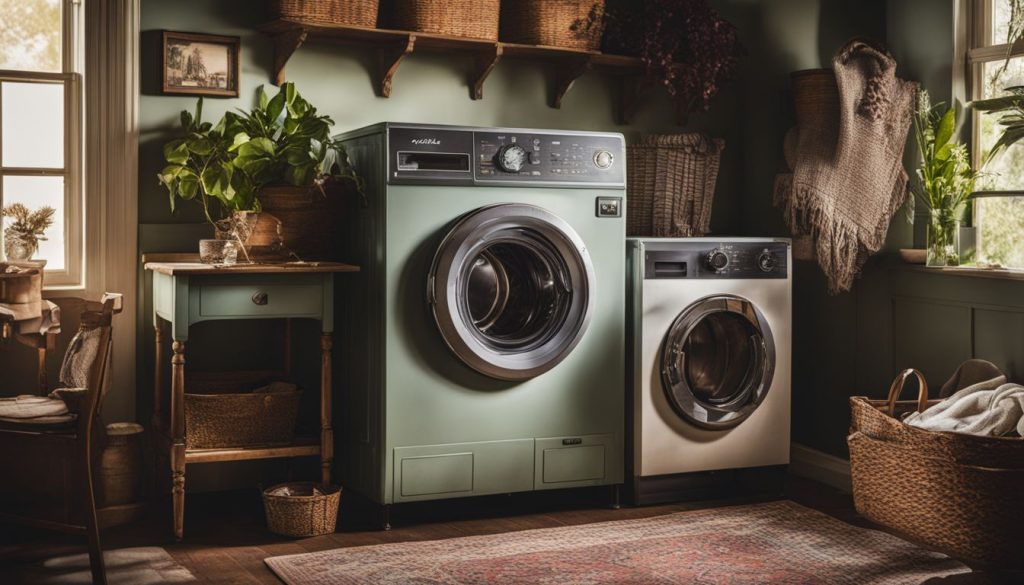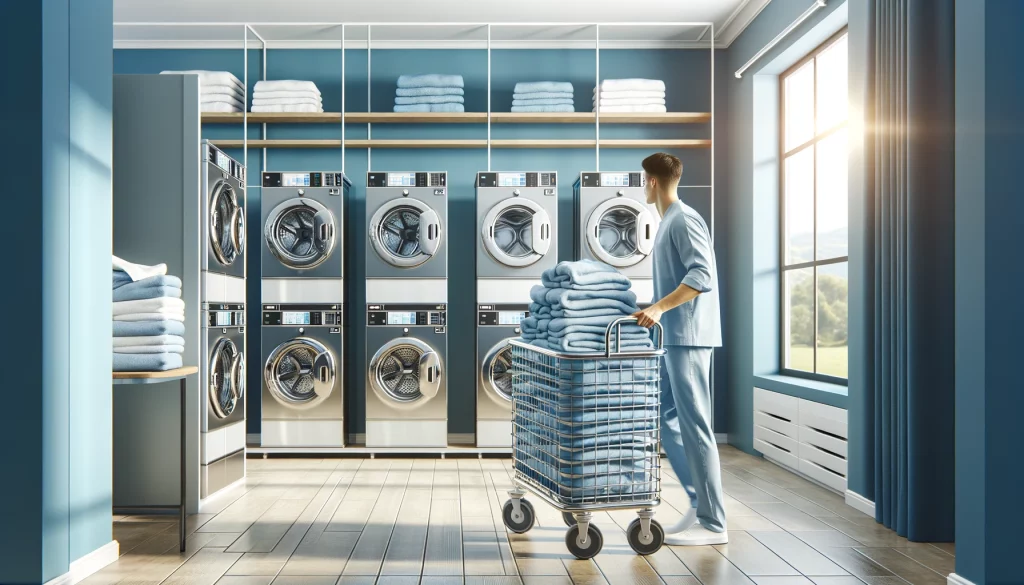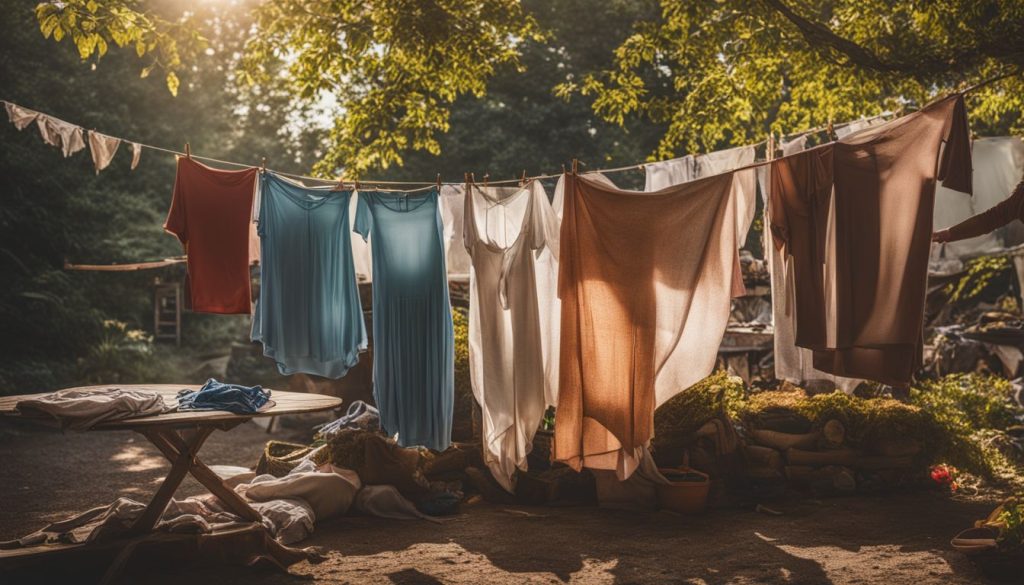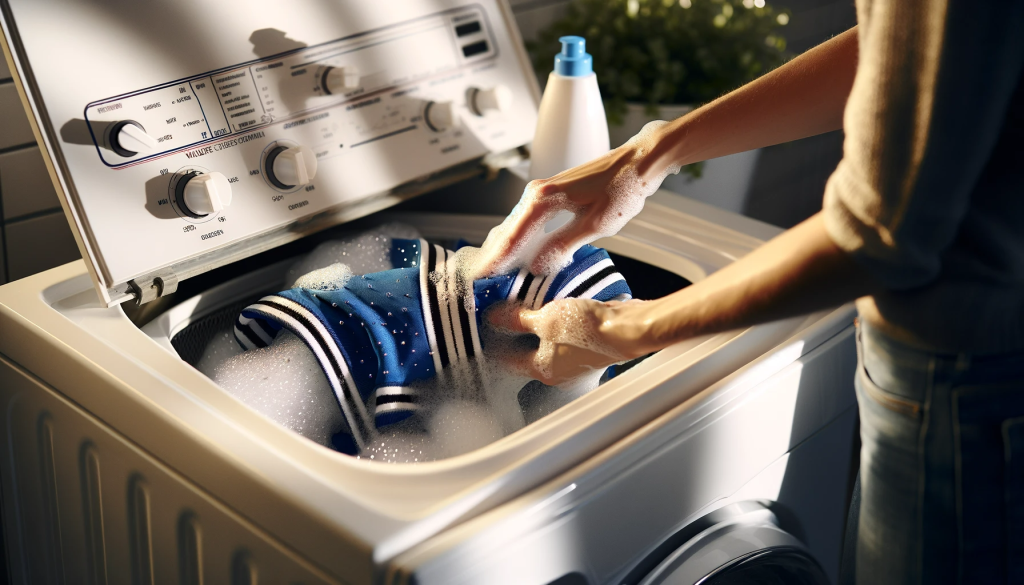Imagine revitalizing your adored wardrobe staples while championing sustainability—this is the magic of professional wet cleaning! By opting for this gentle yet effective method, you can rest assured that your garments are being treated with the utmost care, as opposed to the harsh chemicals of traditional dry cleaning. Visit InktasticMerch to explore how you can integrate this eco-friendly concept into your routine.
Ever found yourself fretting over the best way to clean “dry clean only” clothing without causing any harm? There’s a savvy solution known as professional wet cleaning, which treats these sensitive items with care.
This blog post delves into the marvels of wet cleaning, highlighting its advantages and explaining why it outshines traditional methods. Prepare to discover a refreshing perspective on garment care!
Key Takeaways
- Professional wet cleaning employs water and biodegradable soaps rather than harsh chemical solvents, providing a safer and more environmentally friendly option for garment care.
- This method is especially beneficial for delicate fabrics susceptible to damage from conventional dry cleaning, effectively removing stains while being tender with your clothes.
- Wet cleaning enhances air and water quality, minimizes exposure to harmful chemicals, conserves energy, and is less likely to trigger allergic reactions compared to standard dry cleaning practices.
- As its popularity surges, this method has become more accessible, appealing to both professional cleaners and consumers seeking sustainable laundry alternatives.
- Despite involving water, wet cleaning systems are designed to optimize water use, often leaving garments softer and more pleasantly scented than their dry-cleaned counterparts.
What is Wet Cleaning?

Wet cleaning serves as a gentle and efficient substitute to conventional dry cleaning, utilizing water and tailored detergents to cleanse garments without resorting to harsh chemicals. This eco-conscious technique not only preserves the integrity of clothing but also supports a healthier planet, becoming an increasingly popular option among professional garment cleaners.
Definition and Explanation
Professional wet cleaning is an environmentally friendly method of washing clothes that is both gentle on fabrics and beneficial for the planet. Instead of using harsh chemical solvents typical in dry cleaning, this water-based method employs specialized detergents and technology to clean all types of garments safely, including delicate ones.
Designed to accommodate various textiles, it offers a nontoxic alternative to dry cleaning while maintaining high effectiveness.
This sustainable garment-cleaning technique uses minimal water and carefully formulated soaps that are less harsh than traditional chemicals. By precisely controlling temperature, moisture, and agitation, it delivers a thorough clean while preserving fabric integrity.
Beyond its eco-friendly appeal, professional wet cleaning provides exceptional results with every piece they handle – offering peace of mind for both your closet and the environment.
How it Differs From Traditional Dry Cleaning
Professional wet cleaning significantly diverges from conventional dry cleaning by eschewing harsh chemical solvents in favor of milder water-based solutions that are gentle on fabrics and kinder to nature.
This eco-conscious cleaning method mirrors home laundry techniques but enhances them through the use of advanced machinery and specialized detergents crafted to handle delicate garments with finesse. Wet cleaners utilize technology that meticulously regulates water levels, temperature, and agitation to ensure comprehensive yet safe garment cleaning.
Unlike traditional dry cleaning, which often uses perchloroethylene—a solvent associated with environmental and health hazards—wet cleaning chooses eco-friendly solutions.
These nontoxic optionsnot only minimizes risks to workers handling garments but also prevents chemical residues from remaining in your closet or escaping into the natural world.
The ethos of sustainable cleaning is straightforward: maintaining clean clothes should not compromise our health or the environment.
Advantages and Benefits
Wet cleaning emerges as a leader in green cleaning, presenting a host of advantages that traditional methods cannot rival. It combines the delicate touch required for natural fabric maintenance with the efficiency to achieve spotless results.
- Enhances air and water quality: By avoiding harmful chemicals, wet cleaning significantly reduces the risk of air and water pollution, positioning it as an ecologically safe alternative to dry cleaning.
- Delivers softer clothes with a refreshing aroma: Beyond just leaving garments exceptionally soft, wet cleaning bestows them with a delightful scent devoid of chemical odors.
- Optimizes water usage: Contrary to its name, wet cleaning is a water-efficient laundry method, utilizing water more judiciously than conventional laundering techniques.
- Safeguards your health and the planet’s: With its non-toxic cleaning methods, wet cleaning protects both you and the environment from the dangers of harmful chemicals.
- Performs excellently on diverse textiles: Renowned for being gentle and effective on various fabrics like silk and wool, wet cleaning avoids causing damage or shrinkage.
- Reduces energy use: This eco-friendly cleaning practice often consumes less energy than traditional dry cleaning, as it works at lower temperatures.
- Assures comfort for sensitive skin: For individuals with allergies or sensitivities to chemicals, wet cleaning is invaluable, ensuring irritant-free fabrics for safe contact with skin.
The History and Process of Wet Cleaning

Originating from the transition in garment care, professional wet cleaning fuses age-old techniques with contemporary technology to delicately clean textiles. This approach proceeds through a careful sequence where specialized machinery and non-toxic detergents ensure clothes come out impeccably clean, preserving fragile fabrics and the planet.
How Wet Cleaning Originated
Wet cleaning developed as a creative solution among adept dry cleaners when traditional methods became ineffective. This innovative approach embraced water-based techniques, steering away from harsh chemicals to meticulously handle delicate fabrics and stubborn stains.
Initially, dry cleaners would adopt this method only after consulting clients, as it entailed some risks without standardized practices.
Over time, this alternative cleaning strategy matured from an experimental method into a refined process. Its inception highlights an industry-wide drive for gentler solutions and reflects an adaptability to meet consumer demands and environmental goals.
As wet cleaning demonstrated its capability to rejuvenate garments safely without toxic solvents, it evolved from an overlooked backup plan into a mainstream practice embraced by forward-thinking professionals.
The Steps Involved in the Process
Wet cleaning represents a harmonization of technology and eco-conscious approaches. It revolutionizes garment care through a precise series ofsteps.
- To start, professionals meticulously examine garments, determining the fabric types and identifying stains to ensure appropriate treatment.
- They proceed by pre-treating any specific spots or troublesome areas with eco-friendly cleaning agents.
- Subsequently, the clothes are placed in cutting-edge cleaning machines specifically crafted for wet cleaning processes.
- These machines utilize water alongside green detergents in a gentle cycle, safeguarding the fabric’s integrity.
- Following the wash, professionals choose either state-of-the-art dryers or air-drying techniques best suited to each garment type.
- Once dried, the items receive finishing touches using specialized ironing and pressing tools that enhance crispness while maintaining safety.
- Throughout the procedure, operators, equipped with extensive training in wet cleaning, ensure maximum results are achieved safely.
Requirements for Proper Wet Cleaning
Excelling in wet cleaning transcends merely applying water to fabrics; it involves a nuanced understanding and methodical approach throughout the process. Skilled professionals must be knowledgeable about how various materials interact with water-based solutions, requiring a profound educational foundation.
Advanced equipment offering precise control over moisture, temperature, and agitation is essential, as these elements are crucial for preserving fabric quality during cleaning.
Equally critical are the supplies used; gentle yet potent detergents and spot removers that effectively tackle stains while keeping fabric integrity intact form the backbone of a successful wet cleaning endeavor.
Strict adherence to industry standards ensures that each garment emerges looking pristine without sacrificing environmental or health considerations. Employing these methods with unwavering dedication distinguishes top-tier providers in the ever-evolving garment care industry.
Wet Cleaning vs. Dry Cleaning

Let’s delve into the contrasts between these two powerhouse garment-cleaning methods, exploring which could potentially revolutionize your fabric care and maintenance approach.
Comparison of Methods and Techniques
The way we refresh our wardrobes significantly affects the quality of cleaning and environmental influence. Let’s examine how wet cleaning measures up against dry cleaning concerning their techniques and methodologies.
| Aspect | Wet Cleaning | Dry Cleaning |
| Cleaning Solvent | Involves water and eco-friendly detergents | Depends on chemical solvents like perchloroethylene |
| Environmental Impact | More environmentally conscious; minimizes toxic waste | Potentially harmful to the environment due to chemical use |
| Cleaning Quality | Often results in superior cleanliness | Effective on grease and oil but can be tough on materials |
| Fabric Safety | Generally gentler on a variety of fabrics | May damage delicate materials over time |
| Health Considerations | Lower risk of allergic reactions thanks to non-toxic ingredients | Use of chemicals can pose health risks |
| Process | Comparable to home laundering with advanced machinery | Needs specialized equipment and expertise |
| Water Usage | Modern machines ensure efficient water consumption | Does not require water, butNội dung: proper disposal of chemical waste is crucial |
| Availability | Becoming increasingly accessible | Broadly available; relies on traditional methods |
| Cost | Reasonably priced; subject to location variability | Potentially pricier due to chemical use and waste management |
Examining wet cleaning versus dry cleaning highlights their distinct differences, which can greatly influence your decision. Wet cleaning’s delicate technique not only cleans your garments but also extends their lifespan, offering a blend of efficiency and care. By integrating modern technology, it provides an environmentally friendly approach to garment maintenance.
Pros and Cons of Wet Cleaning
Wet cleaning represents a modern approach to caring for garments, emphasizing eco-friendly practices alongside fabric care. As consumers become more aware of their environmental impact, they consider both the benefits and drawbacks of wet cleaning.
- Eco-conscious: Wet cleaning is notably sustainable compared to traditional dry cleaning, eliminating harsh chemical solvents for a clean and green alternative.
- Fabric-friendly: This method is gentle on clothes, minimizing wear and tear and thus supporting long-term fabric preservation.
- Health Advantages: Choosing wet cleaning reduces exposure to harmful chemicals for clients and staff, fostering a healthier setting.
- Water Efficiency: Although it uses water, wet cleaning systems are engineered to be more water-efficient than typical laundry methods, aiding in conservation efforts.
- Versatile for Fabrics: Thanks to carefully formulated detergents and conditioners, wet cleaning safely handles various fabrics without causing harm.
- Potential Water Usage Concerns: Despite its water efficiency, there’s a risk of water wastage if not properly managed.
- Need for Specialized Equipment: Not every cleaner possesses the advanced gear required for wet cleaning, limiting its availability in certain regions.
- Requires Skill: Effective wet cleaning demands experienced professionals who understand handling delicate fabrics appropriately.
- Accessibility Limitations: While gaining popularity, wet cleaning services might still be less prevalent compared to traditional dry cleaners.
- Sanitation Challenges in Certain Industries: In areas like the food sector, where strict hygiene is necessary, concerns exist about whether wet cleaning can meet sanitary requirements without chemical aids.
Pros and Cons of Dry Cleaning
Dry cleaning has long been trusted for maintaining and rejuvenating clothing marked “dry clean only.” While effective, particularly in managing stains and delicate fabrics, weighing its benefits against its drawbacks is crucial.
- Stain Removal Excellence: Dry cleaning is exceptional at eliminating oil and grease stains from fabrics without inflicting damage.
- Gentle Treatment: Compared to conventional washing, it is less abrasive on clothes, helping garments retain their like-new appearance.
- Ideal for Fragile Materials: By avoiding water, dry cleaning safely attends to delicate fabrics like silk, wool, and velvet, preventing shrinkage or shape alterations.
- Polished Presentation: Garments usually return perfectly pressed, wrinkle-free, and professionally polished—difficult to replicate at home.
- Refreshing Clothes Effectively:water, dry cleaning revitalizes garments by eliminating odors and imparting a fresh feel.
- Chemical Usage: This process relies on chemical solvents such as perchloroethylene (perc), which can pose environmental dangers and potential health threats.
- Costly Over Time: Frequent use of dry cleaning services can become expensive due to charges per cleaned item.
- Possibility of Chemical Residue: Clothes may retain traces of chemicals used during cleaning, which can be troublesome for individuals with sensitive skin or allergies.
- Risk of Fading and Damage: While gentle on clothes, some garments may fade or suffer damage due to repeated chemical exposures over time.
- Environmental Impact: The use of non-biodegradable chemical solvents negatively affects the ecosystem, making it less eco-friendly compared to methods like water-based wet cleaning.
Why Choose Wet Cleaning?
When considering both garment care and the impact on health and the environment, wet cleaning stands out as an innovative solution. This water-based technique not only ensures gentle but effective cleaning for a range of fabrics but also supports environmentally friendly practices that are increasingly crucial in today’s world.
Health and Environmental Benefits

Wet cleaning is a beacon of eco-friendly garment care, avoiding the environmental drawbacks of traditional dry cleaning by not using harmful chemicals and minimizing waste.
This eco-friendly alternative utilizes water—a renewable resource—and biodegradable detergents that are kind to the Earth. With wet cleaning, garments emerge impeccably clean and free from chemical residues that could endanger health or harm the environment.
Energy-efficient cleaning is another key feature of wet cleaning systems; they use less energy and water compared to traditional methods, representing a sustainable choice for environmentally conscious consumers.
By eliminating hazardous substances such as VOCs (volatile organic compounds), wet cleaning secures a safe working environment for staff while ensuring the well-being of customers.
This method epitomizes a shift toward safe, resource-conserving practices in garment care, preserving both resources and health without sacrificing quality.
Safe and Effective for Different Types of Clothing
Wet cleaning is transformative for garment care, especially for delicate fabrics that might be damaged by standard washing methods. This gentle cleaning process effectively removes stains and odors without the harshness of conventional dry cleaning chemicals, making it ideal for silks, woollen suits, intricate bridal gowns, and beaded attire.
Because the process is nontoxic, your favorite clothes are cleaned with minimal risk of fading or texture alteration.
Garments processed through wet cleaning emerge fresh, vibrant, and often feel softer than with other methods. It’s an eco-friendly option not only for your clothing but also for the planet.
Whether you’ve spilled wine on a silk dress or need regular laundering of cotton shirts, wet cleaning technology revitalizes a variety of textiles without compromising the integrity or color of the fabric.
With its capability to efficiently clean diverse clothing styles, choosing
This approach to cleaning with water ensures a safe laundering experience every time.
Availability and Cost
Opting for eco-friendly laundry solutions, like professional wet cleaning, not only preserves your clothes but also can be easy on your budget. This water-based method avoids the costly chemical solvents often used by traditional dry cleaners, which may help reduce your expenses.
Increasingly, local cleaners are providing this non-toxic, environmentally conscious option, making it a viable choice for those seeking sustainable dry cleaning solutions.
Locating a cleaner that offers affordable options like wet cleaning is becoming more convenient. Dependable Cleaners delivers these services along with their more traditional offerings.
By choosing fabric care that is gentler on both your clothes and the environment, consumers can support green practices. As the demand grows, we can expect more wallet-friendly, chemical-free cleaning options to become available, enabling you to make environmentally friendly choices with ease.
Conclusion
Welcome the new wave in garment care through professional wet cleaning. This method blends innovation and sustainability, ensuring your delicate fabrics are well-preserved while also caring for our planet.
Rely on the gentle effectiveness of water paired with specialized detergents to refresh your “dry clean only” clothes without resorting to harsh chemicals. Experience a novel, eco-conscious way to keep your wardrobe in pristine condition.
Let professional wet cleaning be the sustainable choice for maintaining your garments with care for both fabric and the environment.
FAQs
1. What is professional wet cleaning?
Professional wet cleaning is an environmentally friendly technique employed by cleaners to launder delicate fabrics using water and specialized detergents.
2. Is professional wet cleaning safe for all types of clothes?
Yes, professional wet cleaning is safe for the majority of clothing types, including those marked “dry clean only.”
3. Does professional wet cleaning use harsh chemicals?
No, professional wet cleaning avoids the harsh chemicals typically used in conventional dry-cleaning methods.
4. Can professional wet cleaning remove tough stains?
Yes, well-executed professional wet cleaning can effectively eliminate tough stains from your garments.
5. Will my clothes shrink or get damaged with professional wet cleaning?
No, when handled properly by skilled technicians, professional wet cleaning significantly reduces the likelihood of shrinkage or damage to your clothing.
Curious to learn more about sustainable garment care and other eco-friendly practices? Explore our Blog for a wealth of informative articles and tips to help you make better choices for your wardrobe and the environment.




